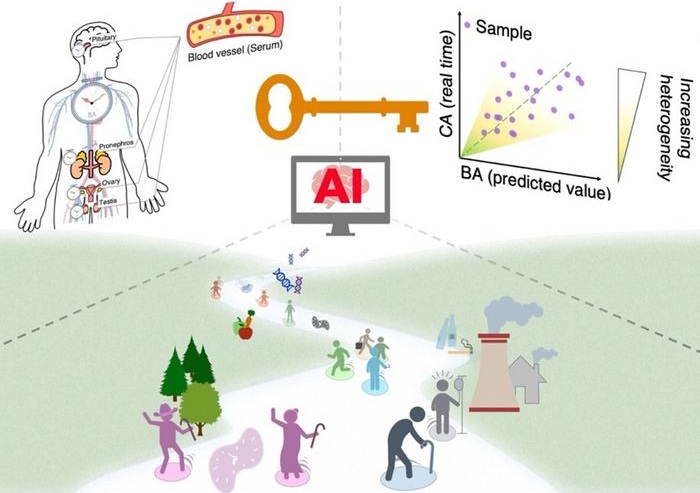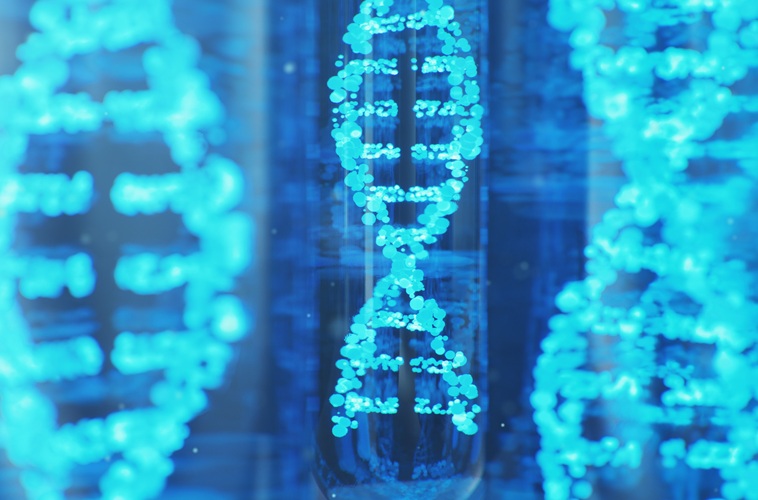AI Model Reveals True Biological Age From Five Drops of Blood
|
By LabMedica International staff writers Posted on 19 Mar 2025 |

Some individuals seem to defy the effects of aging, appearing significantly younger than their peers despite sharing the same age. Aging isn't solely determined by the number of years we have lived; it's also influenced by genetics, lifestyle, and environmental factors. Conventional methods of assessing biological age typically focus on broad biomarkers, like DNA methylation or protein levels. However, these techniques often overlook the complex hormonal systems that regulate the body's internal balance. Now, scientists have developed a novel approach for estimating a person’s biological age, which measures how well the body has aged rather than simply counting the years since birth.
This new method, developed by scientists at Osaka University (Osaka, Japan), uses only five drops of blood to analyze 22 key steroids and their interactions, offering a more precise health assessment. Published in Science Advances, the team’s breakthrough study presents a potential leap forward in personalized health management, enabling earlier identification of age-related health risks and more tailored interventions. Since hormones are essential for maintaining bodily functions, the researchers chose to focus on these as key indicators of aging. To test this hypothesis, the team concentrated on steroid hormones, which are vital in metabolism, immune response, and stress management.
The researchers created a deep neural network (DNN) model that incorporates steroid metabolism pathways, making it the first AI model to consider the interactions between different steroid molecules. Rather than examining absolute steroid levels—which can vary greatly between individuals—the model looks at the ratios of steroids, delivering a more personalized and accurate biological age assessment. Trained on blood samples from hundreds of individuals, the model revealed that biological age differences become more pronounced as people age, an effect the researchers liken to a river widening as it flows downstream.
One of the most surprising findings of the study concerns cortisol, a steroid hormone linked to stress. The researchers discovered that when cortisol levels doubled, biological age increased by about 1.5 times. This suggests that chronic stress could speed up aging at the biochemical level, emphasizing the importance of managing stress to maintain long-term health. The team believes that this AI-driven biological age model could lead to more personalized health monitoring.
Potential future applications for this technology include early disease detection, tailored wellness programs, and lifestyle recommendations to slow the aging process. While the study marks significant progress, the team acknowledges that biological aging is influenced by numerous factors beyond hormones. With continued advancements in AI and biomedical research, the ability to measure—and possibly slow—biological aging is becoming more attainable. For now, the capability to assess an individual’s “aging speed” with a simple blood test could be a revolutionary development in preventive healthcare.
“This is just the beginning,” said Dr. Zi Wang, co-first and corresponding author of this work. “By expanding our dataset and incorporating additional biological markers, we hope to refine the model further and unlock deeper insights into the mechanisms of aging.”
Related Links:
Osaka University
Latest Pathology News
- Novel Technique Uses ‘Sugar’ Signatures to Identify and Classify Pancreatic Cancer Cell Subtypes
- Advanced Imaging Reveals Mechanisms Causing Autoimmune Disease
- AI Model Effectively Predicts Patient Outcomes in Common Lung Cancer Type
- AI Model Predicts Patient Response to Bladder Cancer Treatment
- New Laser-Based Method to Accelerate Cancer Diagnosis
- New AI Model Predicts Gene Variants’ Effects on Specific Diseases
- Powerful AI Tool Diagnoses Coeliac Disease from Biopsy Images with Over 97% Accuracy
- Pre-Analytical Conditions Influence Cell-Free MicroRNA Stability in Blood Plasma Samples
- 3D Cell Culture System Could Revolutionize Cancer Diagnostics
- Painless Technique Measures Glucose Concentrations in Solution and Tissue Via Sound Waves
- Skin-Based Test to Improve Diagnosis of Rare, Debilitating Neurodegenerative Disease
- Serum Uromodulin Could Indicate Acute Kidney Injury in COVID-19 Patients
- First-Of-Its-Kind AI Tool Visualizes Cell’s ‘Social Network’ To Treat Cancer
- New Test Diagnoses High-Risk Childhood Brain Tumors
- Informatics Solution Elevates Laboratory Efficiency and Patient Care
- Microfluidic Device Assesses Stickiness of Tumor Cells to Predict Cancer Spread
Channels
Clinical Chemistry
view channel
New Method Uses Pulsed Infrared Light to Find Cancer's 'Fingerprints' In Blood Plasma
Cancer diagnoses have traditionally relied on invasive or time-consuming procedures like tissue biopsies. Now, new research published in ACS Central Science introduces a method that utilizes pulsed infrared... Read more
Carbon Nanotubes Help Build Highly Accurate Sensors for Continuous Health Monitoring
Current sensors can measure various health indicators, such as blood glucose levels, in the body. However, there is a need to develop more accurate and sensitive sensor materials that can detect lower... Read moreMolecular Diagnostics
view channel
Blood Test for Early Alzheimer's Detection Achieves Over 90% Accuracy
Alzheimer's disease (AD) is a debilitating condition and a leading cause of disability and death worldwide. The availability of reliable diagnostic tools is currently restricted, and diagnosis often relies... Read more
RNA-Based Blood Test Detects Preeclampsia Risk Months Before Symptoms
Preeclampsia remains a major cause of maternal morbidity and mortality, as well as preterm births. Despite current guidelines that aim to identify pregnant women at increased risk of preeclampsia using... Read more
First Of Its Kind Test Uses microRNAs to Predict Toxicity from Cancer Therapy
Many men with early-stage prostate cancer receive stereotactic body radiotherapy (SBRT), a highly precise form of radiation treatment that is completed in just five sessions. Compared to traditional radiation,... Read moreNovel Cell-Based Assay Provides Sensitive and Specific Autoantibody Detection in Demyelination
Anti-myelin-associated glycoprotein (MAG) antibodies serve as markers for an autoimmune demyelinating disorder that affects the peripheral nervous system, leading to sensory impairment. Anti-MAG-IgM antibodies... Read moreHematology
view channel
New Scoring System Predicts Risk of Developing Cancer from Common Blood Disorder
Clonal cytopenia of undetermined significance (CCUS) is a blood disorder commonly found in older adults, characterized by mutations in blood cells and a low blood count, but without any obvious cause or... Read more
Non-Invasive Prenatal Test for Fetal RhD Status Demonstrates 100% Accuracy
In the United States, approximately 15% of pregnant individuals are RhD-negative. However, in about 40% of these cases, the fetus is also RhD-negative, making the administration of RhoGAM unnecessary.... Read moreImmunology
view channel
Stem Cell Test Predicts Treatment Outcome for Patients with Platinum-Resistant Ovarian Cancer
Epithelial ovarian cancer frequently responds to chemotherapy initially, but eventually, the tumor develops resistance to the therapy, leading to regrowth. This resistance is partially due to the activation... Read more
Machine Learning-Enabled Blood Test Predicts Immunotherapy Response in Lymphoma Patients
Chimeric antigen receptor (CAR) T-cell therapy has emerged as one of the most promising recent developments in the treatment of blood cancers. However, over half of non-Hodgkin lymphoma (NHL) patients... Read moreMicrobiology
view channel
Handheld Device Delivers Low-Cost TB Results in Less Than One Hour
Tuberculosis (TB) remains the deadliest infectious disease globally, affecting an estimated 10 million people annually. In 2021, about 4.2 million TB cases went undiagnosed or unreported, mainly due to... Read more
New AI-Based Method Improves Diagnosis of Drug-Resistant Infections
Drug-resistant infections, particularly those caused by deadly bacteria like tuberculosis and staphylococcus, are rapidly emerging as a global health emergency. These infections are more difficult to treat,... Read more
Breakthrough Diagnostic Technology Identifies Bacterial Infections with Almost 100% Accuracy within Three Hours
Rapid and precise identification of pathogenic microbes in patient samples is essential for the effective treatment of acute infectious diseases, such as sepsis. The fluorescence in situ hybridization... Read moreTechnology
view channel
Pain-On-A-Chip Microfluidic Device Determines Types of Chronic Pain from Blood Samples
Chronic pain is a widespread condition that remains difficult to manage, and existing clinical methods for its treatment rely largely on self-reporting, which can be subjective and especially problematic... Read more
Innovative, Label-Free Ratiometric Fluorosensor Enables More Sensitive Viral RNA Detection
Viruses present a major global health risk, as demonstrated by recent pandemics, making early detection and identification essential for preventing new outbreaks. While traditional detection methods are... Read moreIndustry
view channel
Cepheid and Oxford Nanopore Technologies Partner on Advancing Automated Sequencing-Based Solutions
Cepheid (Sunnyvale, CA, USA), a leading molecular diagnostics company, and Oxford Nanopore Technologies (Oxford, UK), the company behind a new generation of sequencing-based molecular analysis technologies,... Read more
Grifols and Tecan’s IBL Collaborate on Advanced Biomarker Panels
Grifols (Barcelona, Spain), one of the world’s leading producers of plasma-derived medicines and innovative diagnostic solutions, is expanding its offer in clinical diagnostics through a strategic partnership... Read more





















